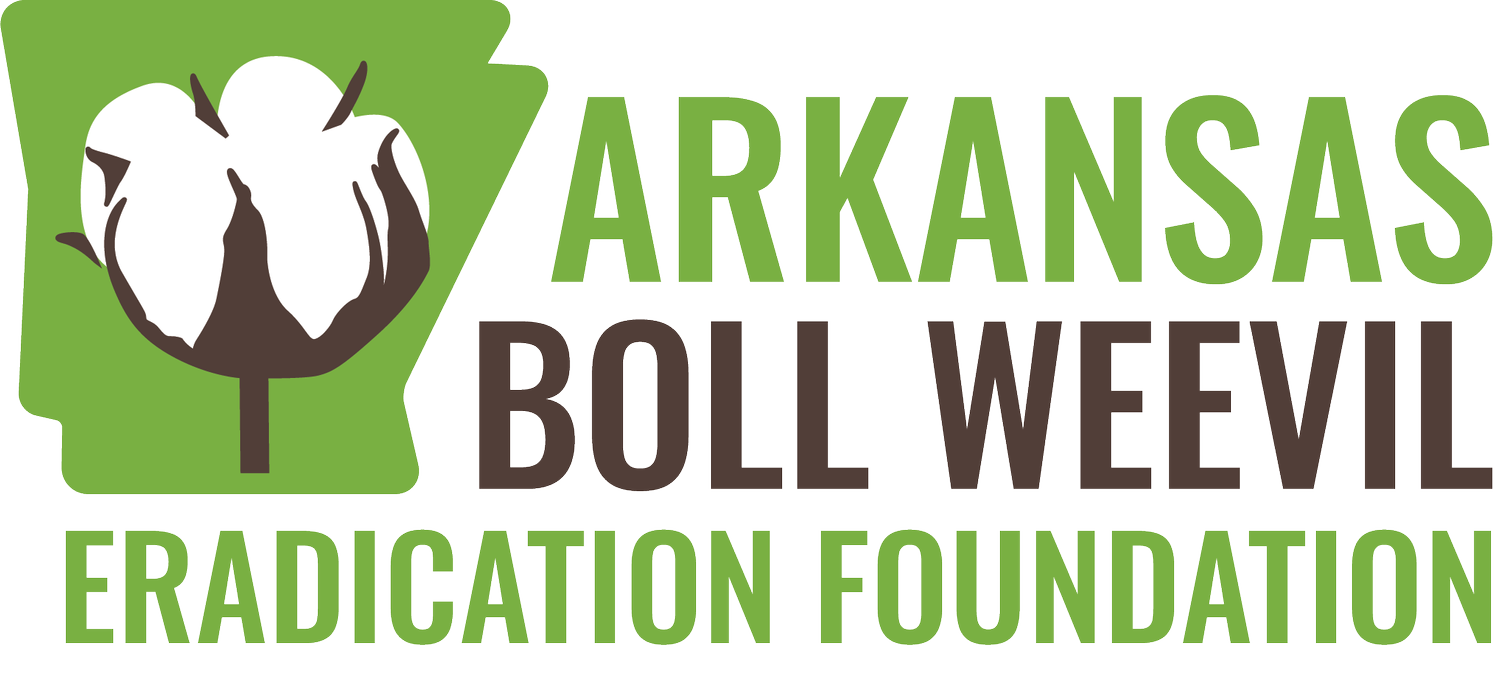
Our goal: eliminate the boll weevil from Arkansas. We succeeded.
What exactly is a Boll Weevil?
The boll weevil is a beetle which feeds on cotton buds and flowers. Thought to be native to Central Mexico, it migrated into the United States from Mexico in the late 19th century and had infested all U.S. cotton-growing areas by the 1920s, devastating the industry and the people working in the American South.
Boll weevils have the ability to completely destroy a cotton crop. By eating the buds of the plant, they make it impossible for the plant to grow and produce cotton. Furthermore, any cotton the plant does manage to produce is ruined by boll weevils either eating it or laying eggs in it.
ABWEF began eradication operations in Arkansas in 1997 in southwest Arkansas counties, and made annual expansions that ultimately included all cotton producing areas. Today, our five Zones stretch across the entire state.
How we eradicated it…
The eradication program was conducted over a five-year period. The first phase of the program in each zone was fall diapause. All cotton fields were mapped and one trap deployed to each field to gather information of the local weevil populations, which helped set a base number of weevils to use for comparison. Aerial and ground applications of malathion were applied weekly starting in August and continuing through defoliation, harvest, and crop destruction or a killing freeze. In the program’s second year, efforts were refocused solely on mapping, trapping and treating fields. Applications in treated fields were based on weevil catches. Once a zone was deemed weevil-free, the maintenance phase of the program was initiated. During this phase, fields continue to be monitored with trapping to ensure the weevil-free environment is maintained.
Mapping of cotton fields under the jurisdiction of ABWEP is done using either handheld GPS units for manual surveying or with the use of modern satellite mapping technology. Each field has a unique number attached to it for identification purposes within the program’s operational procedures. Mapping started in the diapause phase and continues as needed today.
Between the second year and implementation of the maintenance phase, traps are set at a starting density of 300 feet around each cotton field. As weevil numbers decrease, trapping density is reduced. Trapping density eventually spreads out from the initial 300-foot spacing to 900 feet, then to 1,800 feet, and currently, traps are placed at a one-mile spacing in areas where cotton is planted, keeping the program in compliance with national standards.
Treatment of fields is determined from the information collected from the traps. If determined to be necessary, aerial applications of malathion are made using airplanes at a rate of 10 oz. per acre. Helicopters are also used for areas that are difficult to access or deemed sensitive. Ground applications are made using mist blow trucks at a rate of 16 oz. per acre.
The program is primarily funded by a grower assessment charged for each acre grown. In addition to the grower assessment, federal loans and some state funds have helped offset operational costs of the program. Grower assessments are collected annually by the ABWEP. Beginning with the 2020 season, growers will have the option to pay their assessment online.
The early years of the program were front-loaded with eradication operational costs. All zones received various cost share amounts from USDA-APHIS. Along with the USDA-APHIS funding, federal loans and state grants were used to supplement the high startup costs of the program. As the operational costs decreased, the loans were repaid with the final payment made in 2015 to Farm Service Agency. This was done three years ahead of the scheduled pay off.
ABWEF has met its goal of eradication in all zones and currently operates in the maintenance phase of the program.
1800’s
Anthonomus grandis (boll weevil) migrated from Mexico to the U.S. and spread rapidly throughout the Cotton Belt. Since then, it has cost America's cotton producers more than $15 billion - from yield losses and costs to control the insect pest.
1958
The National Cotton Council officially recognized the boll weevil’s economic impact on U.S. cotton production. With Congressional support, this resulted in eradication experiments, a trial eradication program and an area wide boll weevil control program.
1970’s
The National Boll Weevil Eradication Program was launched by USDA's Animal and Plant Health Inspection Service (APHIS). This program later expanded to include states across the south and into New Mexico, Arizona and California.

Get to know our board members.
Find Your Zone
We know how important you are to our state. That’s why we dedicated a single zones page. Once there, you’ll see what information you need to know as a cotton grower.
Beginning with the 2020 season, growers will have the option to pay their assessment online.
If you have questions, please reach out to your zone manager. If you are having trouble getting in contact with them, please visit our contact page or click your zone below to find their phone number and email.








